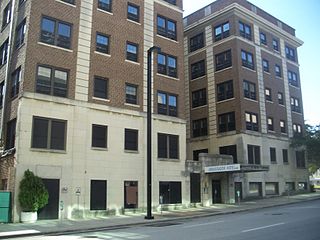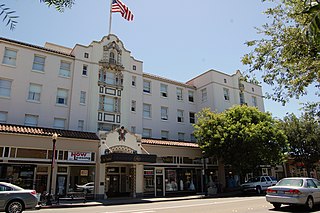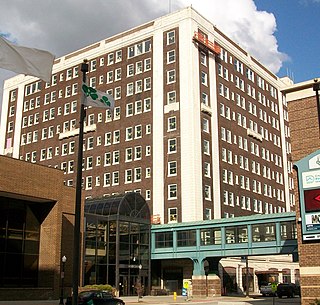
The Auditorium Building in Chicago is one of the best-known designs of Louis Sullivan and Dankmar Adler. Completed in 1889, the building is located at the northwest corner of South Michigan Avenue and Congress Street. The building was designed to be a multi-use complex, including offices, a theater, and a hotel. As a young apprentice, Frank Lloyd Wright worked on some of the interior design.

The 310 West Church Street Apartments, also known as the Ambassador Hotel, is a historic building located at 420 North Julia Street in Jacksonville, Florida, United States. On April 7, 1983, it was added to the U.S. National Register of Historic Places.

55 Wall Street, also formerly known as the National City Bank Building, is an eight-story building on Wall Street between William and Hanover streets in the Financial District of Lower Manhattan in New York City. The lowest three stories were built in 1836–1841 as the four-story Merchants' Exchange and designed by Isaiah Rogers in the Greek Revival style. Between 1907 and 1910, McKim, Mead & White removed the original fourth story and added five floors.

11 South LaSalle Street Building or Eleven South LaSalle Street Building is a Chicago Landmark building that is listed on the National Register of Historic Places and that is located at 11 South LaSalle Street in the Loop community area of Chicago, Illinois, United States. This address is located on the southeast corner of LaSalle and Madison Street in Cook County, Illinois across the Madison Street from the One North LaSalle Building. The building sits on a site of a former Roanoke building that once served as a National Weather Service Weather Forecast official climate site and replaced Major Block 1 after the Great Chicago Fire. The current building has incorporated the frontage of other buildings east of the original site of Major Block 1.

The Park Avenue House is a high rise residential building located at 2305 Park Avenue in the Park Avenue Historic District in Downtown Detroit, Michigan. It was listed on the National Register of Historic Places in 1996. It should not be confused with the nearby Park Avenue Hotel, which was demolished in 2015.

The Eddystone Building is a former hotel located in Midtown Detroit, Michigan at 100-118 Sproat Street. It was listed on the National Register of Historic Places in 2006.

Hotel Woodland is a historic hotel located in Woodland, California and designed by William Henry Weeks. The hotel is on the National Register of Historic Places, and is a contributing property of the Downtown Woodland Historic District.

The Hotel Blackhawk is an eleven-story brick and terra cotta building located in Downtown Davenport, Iowa, United States. It is a Marriott Autograph Collection property.

The Forrest Block is an historic building located in downtown Davenport, Iowa, United States. It was individually listed on the National Register of Historic Places in 1983. In 2020 it was included as a contributing property in the Davenport Downtown Commercial Historic District.

The Davenport Hotel is a historic building located in downtown Davenport, Iowa, United States. It was individually listed on the National Register of Historic Places in 1983. In 2020 it was included as a contributing property in the Davenport Downtown Commercial Historic District. It is currently an apartment building called The Davenport.

Fort Armstrong Hotel is a historic building located in downtown Rock Island, Illinois, United States. It was individually listed on the National Register of Historic Places in 1984. In 2020 it was included as a contributing property in the Downtown Rock Island Historic District. The hotel was named for Fort Armstrong, a fortification that sat in the middle of the Mississippi River near the present location of the Rock Island Arsenal. The building now serves as an apartment building.

The Hotel Fort Des Moines is an historic building located in downtown Des Moines, Iowa, United States. It was listed on the National Register of Historic Places in 1982.

Hotel Ottumwa, formerly known as the Parkview Plaza, is an historic building located in downtown Ottumwa, Iowa, United States. Built as a first-class hotel from 1916 to 1917, it is significant for the part it played in the city's social history and commercial development. By 1915, what had been Otuumwa's first-class hotel, the Ballingall Hotel, was in decline and a group of local businessmen met to plan for the new development. They organized a corporation to sell shares to the local citizens. A total of 309 people bought shares, with the average investment being $500. A further $150,000 was realized by selling bonds. A banquet was held on September 4, 1917 and a grand reception and ball was held two days later to celebrate the opening of the hotel. Over the years various buisinesses occupied the main floor storefronts. Bowling alleys were added in the basement in 1927. Radio station WIAS broadcast from the hotel from 1928, when it moved to Ottumwa from Burlington, Iowa, until 1934 when it went off the air. Major renovations were undertaken in 1939, 1951, and 1982. The building remains a hotel. It was listed on the National Register of Historic Places in 2012.

General Patrick Hurley opened the Ambassador Hotel in 1929, intending it to be a luxury "extended stay" residence for Tulsa businessmen, who were building mansions that were not yet ready for occupancy. Hurley never stayed in the hotel he founded. He moved to Washington, D. C. in March 1929, after President Herbert Hoover chose him to be Secretary of War, after the death of the previous Secretary, who died in December 1929. Hurley never returned to Tulsa.

Hotel Tipton is a historic building located in the central business district of Tipton, Iowa, United States. It was listed on the National Register of Historic Places in 1998. Twelve of Tipton's leading citizens perceived the need for a hotel in town, and each subscribed to $1,000.00 worth of stock to build it. Architect H.W. Zeidler, of Muscatine, Iowa, who also designed the Greenwood Cemetery Chapel in Muscatine, was employed to design the two-story, L-shaped building in the Italianate style. Construction began in 1894 and it was completed the following year. The first floor contained the hotel's lobby, office, sample room, dining room, kitchen, pantries, and four retail units. The stable rents of the commercial space made the hotel economically feasible. The second floor housed 35 guest rooms, a parlor, sitting room, two bathrooms and a sample room. In the late 1990s part of the second floor was converted into apartments.

Lagomarcino-Grupe Company, also known as Rand & Coolbaugh's Block, is a historic building located in the central business district of Burlington, Iowa, United States. It was individually listed on the National Register of Historic Places in 2013, and it was included as a contributing property in the Downtown Commercial Historic District in 2015.

The Hedge Block, also known as Johnson-Rasmussen Building, is a historic commercial building located in the central business district of Burlington, Iowa, United States. It was individually listed on the National Register of Historic Places in 1982. It was included as a contributing property in the West Jefferson Street Historic District in 1991 and in the Downtown Commercial Historic District in 2015.

The Davidson Building is a historic building located in Sioux City, Iowa, United States. It was constructed by local businessmen and real estate developers Ben and Dave Davidson. They saw the need for an upscale office building for professionals. They hired prominent local architect William L. Steele to design the Early Commercial-style structure. It was built by the leading contractor in the city, Lytle Construction Company. Completed in 1913, it was Sioux City's first office building. The exterior of the L-shaped, six-story building is composed of terra cotta panels separated by vertical bands of Roman style brick, and capped with an ornate cornice. It is Sullivanesque in its design. Commercial space is located on the first floor, and office space occupies the upper floors. The building was listed on the National Register of Historic Places in 1999. In 2016 plans were unveiled to convert the building and the adjacent Warrior Hotel into a boutique hotel and apartments. The Davidson Building houses The Warrior Apartments, as well as 56 guest rooms for The Warrior Hotel on its second, third and fourth floors.

The Brazelton House Hotel is a historic building located in Mount Pleasant, Iowa, United States. William P. Brazelton was an early leader in the city's development. He owned the Brazelton Banking House and he was one of the directors of the Brazelton House Company, which built the hotel. It is not clear, specifically, why the hotel bears his family name. The construction of the hotel in 1856 coincided with a building boom in Mount Pleasant with the extension of the Burlington and Missouri River Railroad into town. It was built with the belief that Mount Pleasant would need a large first class hotel, but it had financial problems from the beginning and went through a series of owners until it no longer functioned as a hotel about 1970. The building was listed on the National Register of Historic Places in 1986. In 2015 the upper floors were converted into apartments while the main floor continued to house retail businesses.

The East Saginaw Historic Business District is a primarily commercial historic district located in Saginaw, Michigan and roughly bounded by Federal, North Water, North Washington and North Franklin Streets. It was listed on the National Register of Historic Places in 1982.























